DEPLOYMENTS
Where is DVB-I deployed?
This map shows countries where evaluations or trials of DVB-I have taken place.
Find mor information on the principal DVB-I trials in the table below.
If you are aware of a DVB-I service that should be included here, please let us know via using the form on the front page.
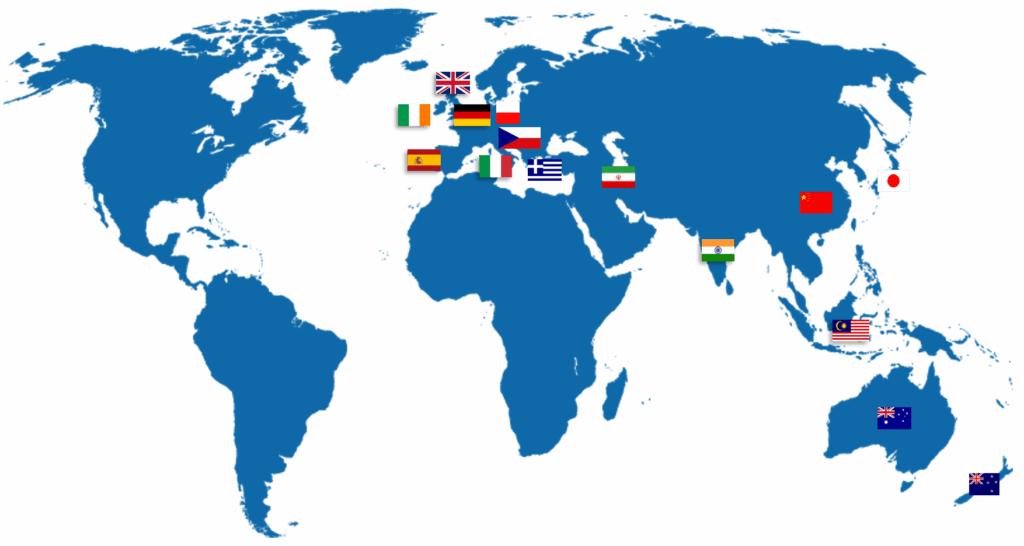
Launched in September 2024 and integrating DVB-I, Sat.tv Connect is the new version of Eutelsat’s free-to-air DTH satellite service, extending the reach of the service to new generations of connected TV sets with integrated satellite tuners.
Sat.tv Connect uses DVB-I to enable unified, seamless content discovery, delivering enriched EPGs that enhance the customer experience. It is used as the standards-based solution for the ‘organization’ of the free-to-air broadcasting environment on the different satellite positions of Eutelsat to:
- Manage multiple service lists per satellite position, with subfiltering by region, country or language (up to 33 different Sat.tv lists so far).
- Optimize and simplify the installation of satellite channels by using the “instant tuning” and “LCN range” functions that are integrated into the DVB-I service list. These guarantee direct zapping to the chosen television or radio channel, without the need for time-consuming pre-scanning of the entire satellite position, and facilitate channel classification.
- Enhance the user experience by enriching the native TV interface with channel logos, thumbnails and programme information that can be integrated directly into the channel’s zapping banner and television guide (with programme information for more than 500 channels to date), thanks to the prioritization, when available, of DVB-I metadata over the broadcast EIT (Event Information Table) that is traditionally used for such information.
- Enable flexible service-list discovery, for both connected and unconnected scenarios, with service-list installation via a broadcast signal that declares either DVB-I entry point parameters or directly the DVB-I services lists.
- Initiate service hybridization, offering the widest free choice of free-to-air broadcast and FAST streaming channels.
For more detailed information, see the article on page 7 of the September 2024 issue of DVB Scene magazine: Enhanced access to free-to-air satellite television thanks to DVB-I
Updated: September 2024
Saorview DVB-I Proof of Concept
Saorview is the national DTT platform in Ireland, owned and managed by the public broadcaster RTÉ. The company is currently investigating the creation of a next-generation hybrid platform.
At IBC2024, on both the DVB and EBU booths, visitors had an opportunity to view the latest phase in the Saorview DVB-I proof-of-concept. The following features were demonstrated:
- Deep-linking from the EPG (Electronic Programme Guide) for catch-up, box sets and the RTÉ Player
- Accessibility services signalled within the service list
- Service prominence
Previously
In early 2023, RTÉ ran a first proof of concept based on DVB-I, leveraging the reference application developed by Sofia Digital on behalf of the DVB Project.
Aims
- Develop a next-generation platform strategy for Saorview
- Meet audiences where they are (including on smartphones and tablets)
- Leverage the increase in IP-based content distribution
- Address future risks to DTT (potential reduction in available UHF spectrum)
- Consider regulatory implications (e.g. around service prominence for public service media
Features demonstrated
- Presentation of linear channels delivered over terrestrial and satellite broadcast and delivered via IP
- Fallback from IP to broadcast and vice-versa if the network currently being used fails
- Presentation of the RTÉ Player at its own spot in the EPG, allowing users to directly open the app from the EPG and play on-demand content
- Presentation of radio stations from both DVB-T and IP
- Display of simple EPG plus channel logos delivered over IP
- Extending LCN (logical channel number) listings beyond those carried in DTT
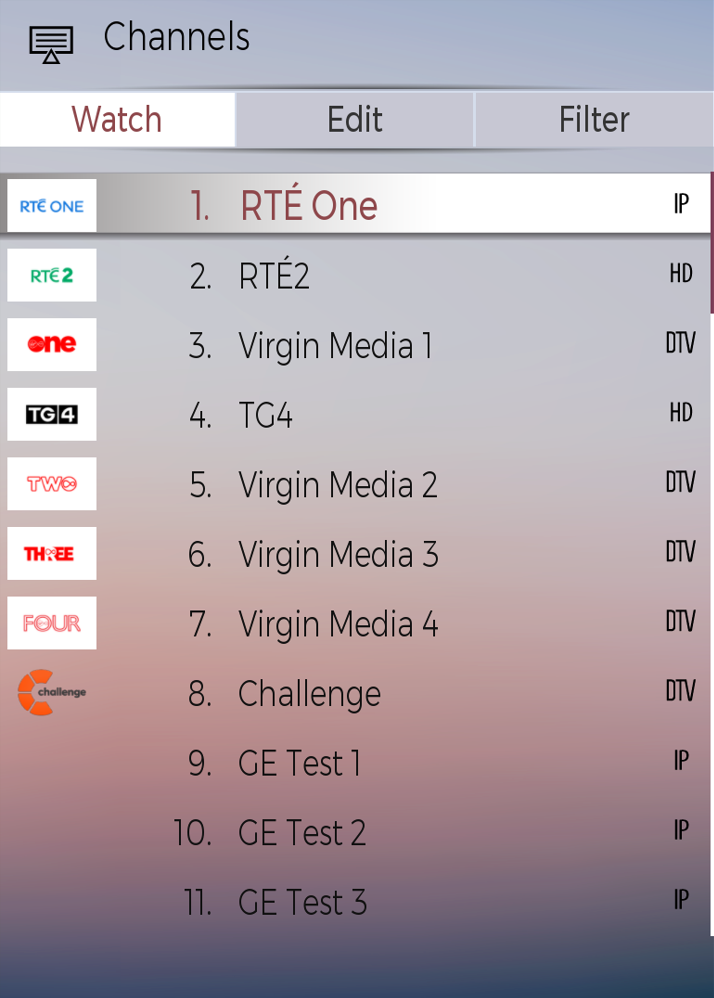
See: EBU webinar presentation by Jim Higgins, RTÉ (May 2023)
Updated: September 2024
Launched Q4 2023, following Mediaset PoC.
For this real market trial of DVB-I, open to any entity meeting the basic requirements, the first compatible TVs, branded Telefunken, are commercially available.

Broadcasters or service providers that participate must be holders of an authorized DTT (digital terrestrial television) LCN (logical channel number) for Italy.
Manufacturers must have successfully passed validation process according to Interoperability Point 2 in DVB BlueBook A177r5 and “DVB-I Market Trial in Italy – Baseline Requirements”.
DVB-I bollino
The trial has been used to develop the conditions for a new reference Italian “bollino” – or label – for the certification of receivers compliant to the requirements included in UHD Book 2.1, published in December 2023 by the HD Forum Italia.
This UHD Book 2.1 sets out the profile to which TV sets must comply in order to pass the certification process running in Italy. It introduces DVB-I, and related functionalities introduced in the HbbTV 2.0.4 specification, in alignment with Interoperability Point 2 of the DVB-I specification. Requiring TV sets to comply with the UHD Book guarantees for users that:
- TV sets on the market behave as expected with respect to required functionalities.
- Different TV set brands behave in a similar way.
UHD Book 2.1 is available online at Documenti – HD Forum Italia
As stated in the “Foreword (DVB-I related)” of the UHD Book:
“The conditions for the launch of a new “bollino” requiring DVB-I specs and testing, will be published after ruling definition by AGCOM on the matter. The market implementation will follow the standard “sunrise period” of 18 months.”
In January 2024, AGCOM is going to establish a technical table to discuss, among other topics, all aspects that must be addressed in order to create a sustainable ecosystem where different mediums (DVB-T/S/I) coexist, observing a well-defined set of rules.
See also:
- Developing a DVB-I strategy for broadcasters in Italy – dvb.org
- La sperimentazione DVB-I di Mediaset è live. Ecco la prova del broadcasting via Internet e del primo TV compatibile (“Mediaset’s DVB-I trial is live. Here is the proof of Internet broadcasting and the first compatible TV”) – DDay.it
Background information
The market trial builds on the Mediaset-led proof of concept (PoC) that had been running since late 2019.

Mediaset began implementation of a DVB-I PoC to develop use cases for an end-to-end chain that complies fully with DVB-I and related standards. It was designed so that it could, in due course, evolve into a full commercial trial.
The PoC was managed by Mediaset, which also acted as a service provider. Over the course of the PoC, many Partners joined the activities, as illustrated below.
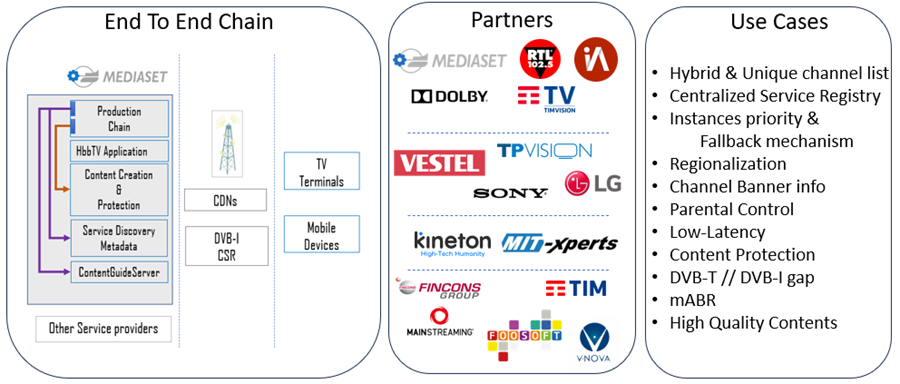
The above diagram shows:
- the end-to-end testbed developed to fully test the entire chain;
- the partners involved in the PoC;
- the use cases implemented.
In parallel with the PoC and in collaboration with colleagues involved in the German DVB-I Pilot, results of the tests formed the basis of updates to the DVB-I specification. The July 2023 edition of the spec, DVB BlueBook A177r5, introduced “Interoperability Point 2”, which allows different markets to have a clear reference, avoiding market fragmentation.
PoC Phase 2
In parallel with the market trial, in Q4 2023 Mediaset initiated Phase 2 of its PoC to:
- Test and profile new use cases;
- Provide further input into the evolution of standards in DVB and HbbTV;
- Provide new broadcasters and manufacturers interested in joining the Market Trial a valid test environment.
As for the original PoC, Phase 2 will be based on a flexible and proactive collaboration between all partners.
Contact
For more information on the Market Trial and the PoC Phase 2 contact Stefano Braghieri (stefano.braghieri@mediaset.it).
Updated: January 2024
In March 2025, a press release announced that public and private television broadcasters were working together with associations and organizations to develop a framework for the market launch of DVB-I in Germany.
The “DVB-I Round Table” was initiated in 2024 to prepare the conditions for the market launch of DVB-I in Germany, under consideration of aspects of media and antitrust law. Under the moderation of the media authorities ARD, ProSiebenSat.1 Media, RTL Deutschland, ZDF, the Federal Network Agency, VAUNET, and ZVEI are participating.
Organized by the Round Table, working groups began addressing relevant detailed questions for a possible DVB-I offering in Germany at the beginning of 2025. The main focuses of the working groups are the definition of product requirements, the organization and operation of a joint service list, aspects of non-discriminatory access for programme providers, the discussion about certification of receiver devices, and the creation of a road map up to the market launch.
For more information, see the full press release.
Previous updates
The German DVB-I Pilot has been in its second phase since IBC2023. Stakeholders are working towards a commercial trial.
- The regulators have convened a Round Table to consider business and regulatory preparations towards regular operation of DVB-I in Germany.
- The Deutsche TV-Plattform’s DVB-I Task Force is working on an implementation profile.

Pilot Phase 2
Phase 2 of the German DVB-I Pilot (see below for information on Phase 1) began in September 2023. It targets aspects that would represent the foundations for a market launch of DVB-I in Germany.
The next milestone is the creation of an organizational entity that neutrally reflects the interests of all market participants.
The key points of Phase 2 include:
- the technical–organizational provision of the German DVB-I service list;
- implementation of the public value recommendation of the German state media authorities;
- server-side regionalization based on the postal codes;
- expansion of DRM (digital rights management) and subscription services;
- and the evaluation of new use cases for playlists, pop-up channels and media library deep links in content guides.
In addition to resolving challenges in the integration of legacy broadcast systems, the pilot is also focused on the latest developments with the DVB-I specification, such as the signalling of accessibility services, added to the specification in Q1 2024.
May 2023: Final report on Phase 1 available in English (PDF) and German (PDF)
See also: Major pilot of DVB-I launched in Germany
Objectives
The pilot is a limited duration collaboration to develop a common understanding of the DVB-I functionality as well as a standardized future scenario to include the complete DVB-I ecosystem. Participants are broadcasters, TV manufacturers and software companies. The pilot will be launched at IBC2022. The objectives include:
- Develop a common, standardized future scenario
- Demonstrate the potential of DVB-I
- Demonstrate a vision for a national market scenario
- Show technical cooperation between public service broadcasters and private broadcasters
- Elaborate on solutions for DRM and subscription-based services business models and technical solutions for private content providers or platform operators
- Identify technical gaps and requirements in the DVB-I standard
- Gather experience with aggregation of service lists
- Pave the way for a potential launch of DVB-I Services in Germany
- Validate the user experience
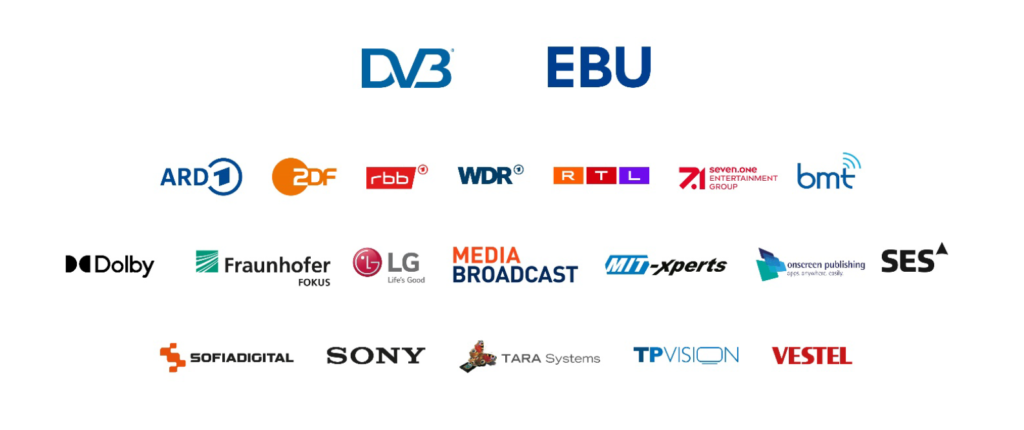
Target market
Germany
Pilot architecture and features
- HbbTV is an integral part of our services today. DVB-I enables the integration of the entire HbbTV ecosystem with all services and accessibility features.
- Solutions for DRM and subscription-based services in DVB-I service lists are demonstrated.
- Extra available event channels can be added to the service list dynamically for the event duration.
- Regionally different channel sorting can be offered on the basis of region-specific LCN tables. This way the viewer can be offered the locally appropriate channel as well as other locally relevant channels in prominent programme positions. The region selection can be made – if supported by the unit – by postcode entry or direct selection in the menu.
- The EPG with link to the media libraries enables convenient and direct access to Video on Demand for missed, catch-up and pre-released programmes.
- Playlists as channels combine videos from a genre such as news or curated formats such as Terra-X or WDR Retro into a linear service. It is also possible to navigate freely in the playlist.
- Same as in the satellite bouquet, we also provide radio in DVB-I. The channels are enriched with informative VisualRadio applications for the big screen.
- The pilot demonstrates a unified service list for the German market, as it could also be specified by a regulator.
Other features of the pilot
- Hybrid services with DVB broadcast and MPEG-DASH, low latency HEVC streaming
- Instance prioritization and fallback switching
- Next Generation Audio / AC4
- Service list aggregation & discovery via the Central Service Registry (CSR)
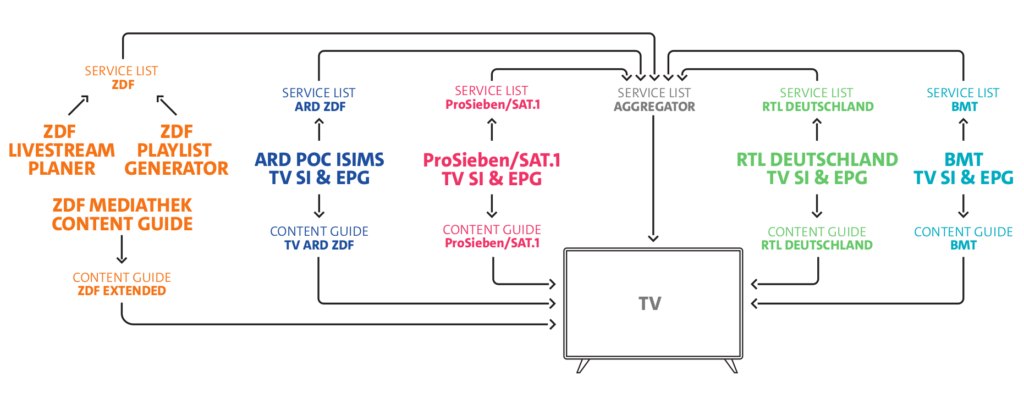
Receivers/clients
Official DVB-I reference application (developed by Sofia Digital), plus clients from Fraunhofer FOKUS, LG Electronics, OnScreen Publishing, SONY, TARA Systems, TP Vision (Philips) .
The national list is provided by an aggregator service from bmt. The terminals determine the correct list via the DVB reference CSR.
Future plans
Public available clients, user tests, extension of the service list with additional radio services and apps; general improvements; continued engagement with DVB CM-I, particularly around audio streaming.
Contact
For more information on the pilot contact Remo Vogel (dvb-i@rbb-online.de).
Updated: March 2025
The March 2025 issue of DVB Scene magazine included an article announcing a DVB-I pilot, as part of a collaboration between RTVE (the Spanish national public service media organization) and FORTA (the association of regional public media services).
The pilot, which will last for one year, will involve a series of technical tests related to the DVB-I standard in order to assess its suitability as a strategic tool to strengthen and enhance the positioning of the Spanish public and licensed audiovisual media service providers. It seeks to optimize the discovery and findability of their content while aiming, as much as possible, to improve the visibility and the prominence of their services.
—
Previous activities
In April 2023, the Spanish public broadcaster RTVE and the Polytechnic University of Madrid (UPM) undertook a public test of DVB-I under the auspices of the RTVE Chair at UPM.
A live event featured the first pilot of RTVE channels delivered using DVB-I linked to a digital terrestrial television (DTT) broadcast. The event included a demonstration of the channel tuning procedure.
Other companies contributing to the initiative included Cellnex Telecom, Dolby, Sapec and the Televés Corporation, all of whom are on the advisory committee of the RTVE Chair at UPM. Receivers for the tests were supplied by Vestel, who provided development software with new DVB-I support running on current range of their production TV sets.
The pilot also made use of the DVB-I reference application to generate the service lists.
DVB-I signalled over DTT
For the event, a custom DTT multiplex was created by UPM engineers and broadcast in the local area on a temporary channel. The multiplex included a link to the DVB-I service list in the DTT service information tables, and the channels were automatically available to the user by simply pressing the EPG button on the remote control. It is believed that this was the first time a DVB-I service list had been signalled over the air in this way.
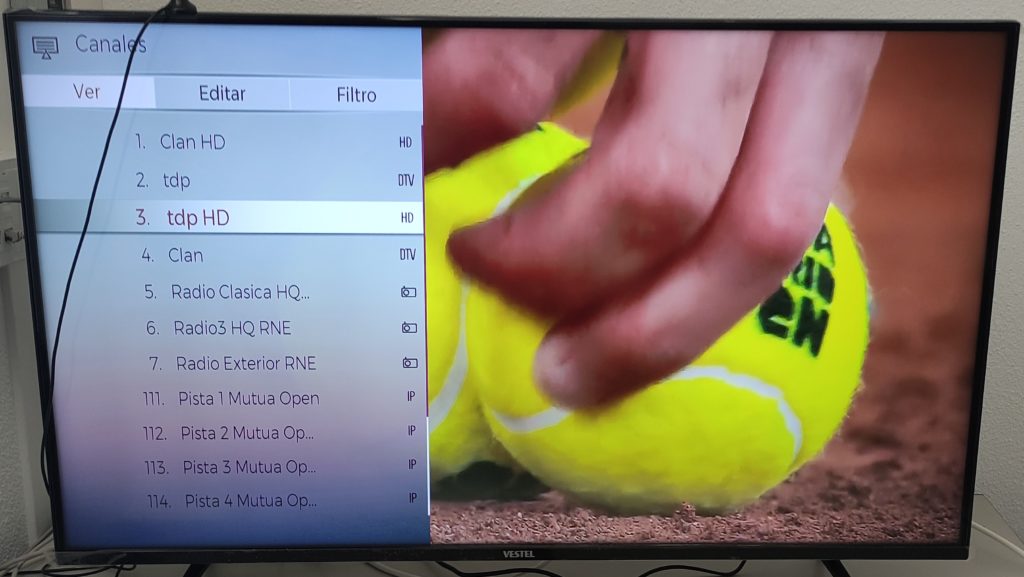
The test was built around the Mutua Madrid Open tennis tournament, which was being broadcast on the tdp HD channel as a single feed. Thanks to DVB-I, users were able to select the coverage of any of the seven tennis courts through additional channels, allowing any match to be chosen without the use of an app. The user was shown eleven channels (four DTT plus seven delivered via the internet) through which they could navigate.
Find more information (in Spanish) on the RTVE website.
Updated: March 2025
IRIB R&D develops innovative new products and technologies in broadcasting and broadband delivery, laying the groundwork for future services from IRIB (Islamic Republic of Iran Broadcasting).
The testing of DVB-I in the IRIB R&D laboratory began in March 2020. The goal of the pilot was the evaluation of DVB-I with regard to its feasibility and the potential benefits for IRIB. The pilot was completed in October 2020.
You can find more information about this pilot in the articles below:
- Issue 288 of the Asia-Pacific Broadcasting Union Technical Review (Oct-Dec 2021) (PDF)
- Issue 56 of DVB Scene (Sep 2020) (PDF)
Target market:
The pilot was available in the Tehran area. The user interface was in the Persian language.
Service lists and services:
IRIB created its own service list registry, within which was the service list used for this pilot. The service list contained 60 service instances, some as DVB-T, some as DVB-DASH and some with both types of delivery. MPEG-4 video coding was used.
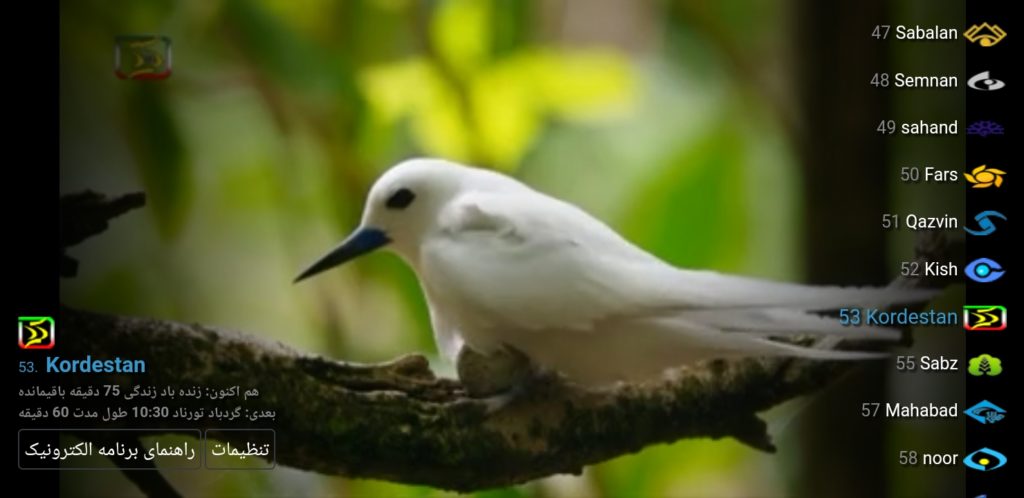
Receivers/clients:
The trial was based on the official DVB-I reference application (developed by Sofia Digital). HbbTV receivers and Android TVs and smartphones were used.
Future plans:
Integrating all IRIB DVB-T/T2 and OTT services into the DVB-I service list and adding the client to the main IRIB HbbTV launcher. Also under study is the use of DVB-I for service discovery in 5G.